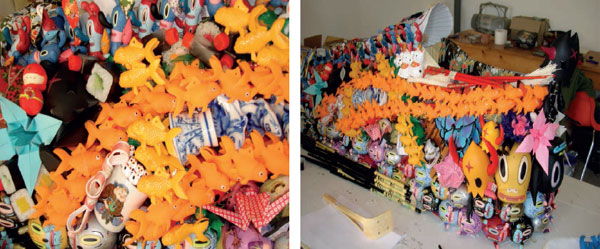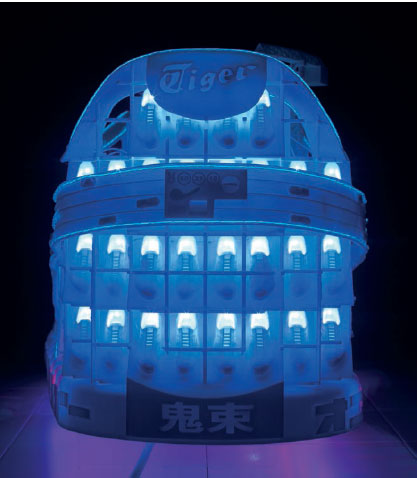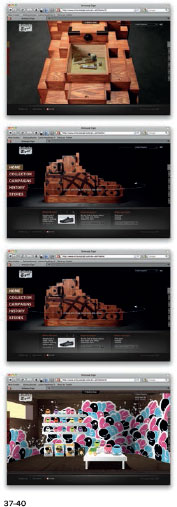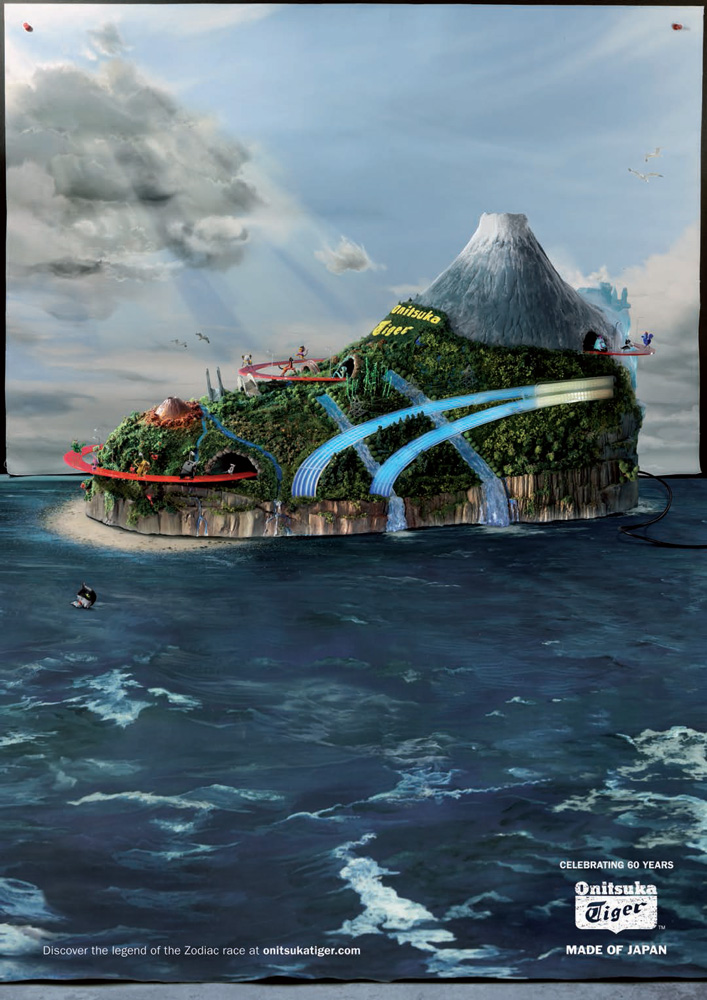Onitsuka Tiger
Made of Japan
Amsterdam Worldwide
The sports fashion world is a crowded one, so when Japanese brand Onitsuka Tiger wanted to do a brand campaign for its shoe line, it knew that it needed something unusual to stand out. Advertising agency Amsterdam Worldwide looked to the company’s history for inspiration. ‘Since they relaunched in 2001, they hadn’t really told their story, which is really interesting,’ says creative director Andrew Watson. ‘It’s certainly got a really interesting heritage, probably more so than most of the other brands. In fact, as a basic brand, Onitsuka Tiger pre-dates Nike, so it’s really got some stories to tell. To tell those stories we needed a delivery device, or something that we could use as an icon year after year.’


01-03 Advertising agency Amsterdam Worldwide created a series of sculptures for Japanese brand Onitsuka Tiger to advertise its shoe line. The sculptures are all based on the design of the shoe, and each highlights different aspects of Japanese culture. The first in the series, shown here, featured various iconic symbols of the country.
’At least, that’s how we envisioned it’, Watson continues; ‘something that we could build on that embodied what the brand stood for, which we encapsulated into the line “Made of Japan”.’ The device the creatives chose was to focus on the shoe itself, but turn it into a work of art. Between 2007 and 2010, four shoe sculptures were made, with each one articulating a different aspect of Japanese culture. The first took the ‘Made of Japan’ tag literally, with a 1.5-metre-long shoe sculpture created from various iconic symbols of the country, including sushi and origami, koi carp and vinyl toys. For the second, titled Electric Shoe, Amsterdam Worldwide focused on the neon landscape of Tokyo, with the sculpture itself becoming a miniature city, complete with brightly lit highways and even a replica of Tokyo’s Narita Airport contained in the shoe’s tongue. The third sculpture reflected the Japanese legend of the Zodiac Race, while the fourth is inspired by the Japanese Tansu chest, a piece of furniture containing many drawers.
It was important to Amsterdam Worldwide that the shoes were real, handcrafted objects, rather than just images created in CGI. ‘It would have been easier to make them in CG; it would have been easier to not make the real thing,’ says executive creative director Richard Gorodecky. ‘But it would have been kind of heartless – there was something about the process and the pain of actually building something that really elevated them above what they could have been just as concepts. We love to make stuff.’
‘Each one’s been a totally different experience, but each experience has been really fantastic in its own way,’ says Watson. ‘From the first one, where we were building the model in a garage, to the last one, where we were in a workshop in Osaka working with a company who are nine generations of traditional woodcrafters.
‘The Electric Shoe was especially interesting because we were working with a company that was doing something quite new, which was rapid prototyping, and using that technique to create something that was going to be consumed by an advertising audience was quite unprecedented at the time.’
Fans of the shoes get the opportunity to see them in the flesh by visiting the brand’s flagship stores. ‘The very first one was a one-off,’ says Watson, ‘and it needed to be because the budget pretty much made it so. We could only afford to make one.
That became popularized by a tour that we did – we sent it around Europe and to the flagship stores, and it actually became a centrepiece for their displays for a year. It almost became an exhibition piece. Then in the years following, the popularity of the models grew, so stores wanted to have their own ones. So we had to figure out ways of creating them so we could potentially duplicate them or make scale models of them. What it meant was that more people could see the finished article and could interact with them, especially in the case of the last one, the Tansu shoe, which is the most interactive.’
‘Budget has always been a problem, but that problem has actually caused us to do quite incredible things.’

04-05 Images showing the construction of the first shoe in the Made of Japan series.

06 Still from a film featuring the shoe, made to accompany the campaign.
07-08 Each shoe sculpture was photographed and used in press and poster advertising for the brand. Shown here are the print ads featuring the one metre-long Electric Shoe.

09 The back of the Electric Shoe sculpture was used to display real Onitsuka Tiger shoes.

10-11 The final shoe sculptures were exhibited in Onitsuka Tiger’s flagship stores. Other small accessories, including key rings and USB sticks, were also created as part of the Electric Shoe campaign.

12 A film, shot in the shoe, was created as part of the campaign. Viewers were taken on a journey through the tiny electrified streets featured in the sculpture.
13 For the 2009 shoe sculpture, which also marked Onitsuka Tiger’s 60th birthday, the agency created a diorama based on the Asian legend of the Zodiac Race.

14-18 The sculpture featured a race circuit, as well as several Japanese landmarks including Mount Fuji. The photographs here reveal its slow creation.
19-20 The Zodiac Race legend tells of 13 animals that race each other for a place in the Zodiac calendar. To accompany the shoe sculpture, the agency created an animated film to bring the race to life, starring various animal characters. Shown here are early character designs as well as stills from the finished film.
‘It would have been easier to make them in CG; it would have been easier to not make the real thing. But it would have been kind of heartless – there was something about the process and the pain of actually building something that really elevated them above what they could have been just as concepts.’

21-36 In 2010, Amsterdam Worldwide created the Tansu Shoe for Onitsuka Tiger, which contained a number of beautifully carved wooden boxes and drawers. The ad agency worked with craftsmen at a traditional woodshop in Japan to create the shoe.

37-40 A website formed part of the campaign, where viewers could open the drawers to find stories about Onitsuka Tiger’s heritage, as well as films, photos and other fun stuff.
The shoes have formed the content for print campaigns, and each one has also been accompanied with a film and website. In the case of the Tansu shoe, the site allowed visitors to access the drawers of the shoe online, and find more brand-related treats. ‘These campaigns from the outset were never big budget and yet they still had to transcend different nationalities and country borders, so we wanted to create something that was integrated,’ says Watson. ‘We knew that doing something online was important, but we needed, in a kind of mercenary way, to create as much PR as possible to back them up, because we didn’t have the budget to put them in all the media. So we needed them to generate their own buzz.’
This has been successful, with bloggers and fans of the shoes eager to share the story of any new arrivals to the campaign. This word-of-mouth approach has allowed Onitsuka Tiger to carve out a niche for itself against competitors who have larger advertising budgets and a broader presence. ‘Budget has always been a problem, but that problem has actually caused us to do quite incredible things,’ says Gorodecky. ‘So the thing that’s probably worked against it all these years has actually been the thing that’s advanced it, and pushed us to do things in different ways. The biggest problem has been the biggest advantage.’




